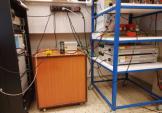Name of the standard: National Standard of Thermal Neutron Fluence Rate
Code designation: ECM 440-3/20-064
Year of promulgation: 2020
Department: section 1015 CMI OI Prague, IZ building
Guarantor: Ing. Zdeněk Vykydal, Dr.rer.nat.
Thermal neutrons are those whose kinetic energies are in thermal equilibrium with the atoms of the environment. The corresponding energy interval is 0.002 to 0.5 eV (5×10-07 MeV). The upper limit is given by the so-called cadmium edge, i.e. the energy at which the absorption effective cross section of cadmium drops by about three orders of magnitude.
The fluence rate of thermal neutrons is given in cm-2.s-1. Thermal neutrons are obtained by having a neutron source, whether a radionuclide, an accelerator or a nuclear reactor, emit neutrons into a moderator, i.e. a material in which the neutrons lose energy by collisions and are practically not absorbed. On reaching thermal equilibrium with the moderating medium, the neutrons have the same energy distribution as the atoms of the medium. This distribution is described by the Maxwell-Boltzmann distribution, which at a temperature of 20C corresponds to a mean energy of 0.0253 eV or a mean velocity of 2200 ms-1. The best moderating material is heavy water, but graphite works better, hence the graphite-based CMI thermal neutron source.
The National Standard of Thermal Neutron Fluence Rate consists of the following parts:
- graphite moderator with a 40 × 40 × 135 cm3 open irradiation channel.
- set of six neutron sources.
- calibration bench, fixed to the graphite prism, allowing reproducible positioning of the thermal neutron detector/verification gauge in the thermal neutron field.
Basic metrological characteristics:
- Irradiation channel dimensions: 40 cm × 40 cm × 135 cm
- Relative contribution of thermal neutrons in the spectrum: >92%
- Relative homogeneity of neutron flux: ± 2%
- Neutron fluence power range: Φ = (1.0×103 to 2.9×104) cm-2.s-1 ± 3.6% (k = 2)
- Neutron dose equivalent power range:
- Ḣ*(10) = (60 to 1770) µSv/h ± 8.8% (k = 2)
- Ḣp(10) = (60 to 330) µSv/h ± 8.8% (k = 2)

